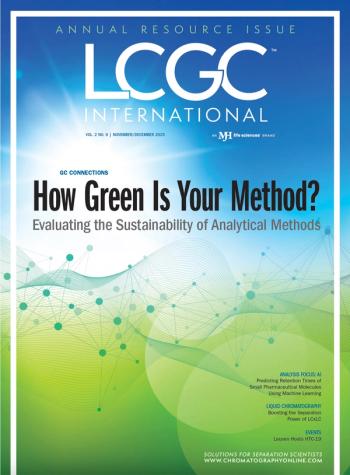
- The Column-09-04-2014
- Volume 10
- Issue 16
Chiral Separation of I-MAMP and d-MAMP in Saliva
Saliva is becoming ever more commonly used in drug testing over urine or blood samples because of its ease of collection. As such, existing testing methods are being adapted for application to accommodate a change in sample matrix. In a new study published in the Journal of Chromatography A, scientists from the National Institute on Drug Abuse (Maryland, USA) and the University of Maryland Baltimore (Maryland, USA) present the use of precolumn derivatization using N(?)-(2,4-dinitro-5-fluorophenyl)-l-alaninamide (Marfey?s reagent) prior to liquid chromatography–mass spectrometry (LC–MS) analysis for the quantitation of chiral amphetamines in plasma and saliva.1
Photo Credit: Science Photo Library/Getty Images
Saliva is becoming ever more commonly used in drug testing over urine or blood samples because of its ease of collection. As such, existing testing methods are being adapted for application to accommodate a change in sample matrix. In a new study published in the Journal of Chromatography A, scientists from the National Institute on Drug Abuse (Maryland, USA) and the University of Maryland Baltimore (Maryland, USA) present the use of precolumn derivatization using N(α)-(2,4-dinitro-5-fluorophenyl)-l-alaninamide (Marfey’s reagent) prior to liquid chromatography–mass spectrometry (LC–MS) analysis for the quantitation of chiral amphetamines in plasma and saliva.1
Methamphetamine (MAMP) exists as two enantiomers that are structurally similar but have very different effects on the human body. The l-methamphetamine (l-MAMP) form can be found in over-the-counter decongestants and is not a controlled substance, whereas d-methamphetamine (d-MAMP) is a pyschostimulant and is tightly controlled. Corresponding author Marilyn A. Huestis told The Column: “We started this study to provide scientific evidence on important questions for the approval of oral fluid testing for federal workplace drug testing. In the past, Vicks VapoInhaler (Procter & Gamble) administration, an over-the-counter decongestant, produced positive methamphetamine urine screening tests and positive confirmation tests. A further chiral analysis was necessary to separate d-methamphetamine (the psychoactive compound) from l-methamphetamine (non-psychoactive compound). It was important to know what would occur if someone used Vicks VapoInhaler and oral fluid was collected. Our research’s specific aims were does Vicks VapoInhaler administration cause positive methamphetamine oral fluid results, and if a chiral analysis is performed will d-methamphetamine or l-methamphetamine be present?”
Drug-free plasma was taken from the NIH blood bank and blank oral fluid samples were collected from volunteers. Derivatization was performed using N(α)-(2,4-dinitro-5-fluorophenyl)-l-alaninamide (Marfey’s reagent) before liquid chromatography–electrospray ionization–tandem mass spectrometry (LC–ESI–MS–MS) analysis. The method was then applied to test fluids collected from a volunteer who had been using a decongestant previously associated with positive test results and found the presence of l-MAMP but not d-MAMP. Huestis told The Column: “This is the first reported LC–MS–MS method for chiral amphetamines analyses in plasma and in oral fluid collected with two collection devices, Quantisal and Oral-Eze. We achieved 1 µg/L sensitivity, lower than most published protocols, and enantiomers were resolved rapidly in <10 min. The key to the procedure was the incorporation of a cost-effective chiral derivatization reagent, N(α)-(2,4-dinitro-5-fluorophenyl)-l-alaninamide or Marfey’s reagent, that allowed us to perform separations with a reverse phase C18 column and avoid expensive chiral columns. While it is not common to perform derivatization with LC methods, we found it greatly improved our methods performance over more traditional chiral LC methods.” — B.D.
Reference
1. M.N. Newmeyer, M. Concheiro, and M.A. Huestis, Journal of Chromatography A 1358, 68–74 (2014).
Articles in this issue
over 11 years ago
Fractal Chromatography: A New Phase in Separation Science?over 11 years ago
The LCGC Blog: Capillary GC Liner Selection Guideover 11 years ago
Making it Crystal Clear: Detecting PPCPs in Water Using LC–MSover 11 years ago
International Symposium on GPC/SEC and Related Techniquesover 11 years ago
Pesticides in Fruit Determined by Fast LTP–Orbitrap–HR–MSover 11 years ago
Vol 10 No 16 The Column September 08, 2014 North American PDFover 11 years ago
Vol 10 No 16 The Column September 04, 2014 Europe and Asia PDFNewsletter
Join the global community of analytical scientists who trust LCGC for insights on the latest techniques, trends, and expert solutions in chromatography.



